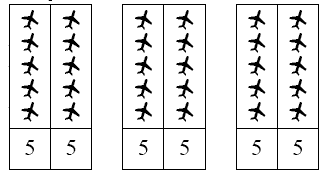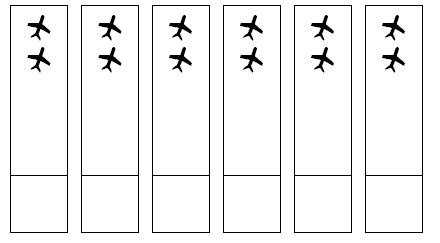Derive multiplication facts from 2, 5 and 10 times tables.
Number Framework Stage 6
Using Materials
Put down four five-fly cards number side up.Ask, How many flies are on these cards altogether? (twenty)How many flies are on the back? (none)Record the operations as 4 × 5 = 20. Place more five-fly cards down to illustrate other times five facts. Focus on the relationships between fives and tens by grouping the cards in pairs:
6 × 5 is the same as 3 × 10
Move to examples that show the relationships between multiples of five and other multiples through building on or taking off.
For example, place down six six-fly strips number side up. Ask, The cards show four times six but you can only see four times five. How many flies is that? (twenty). How many flies do you think will be on the back? How do you know? (four since there is one fly on the back of each card) How many flies is that altogether? (twenty and four,twenty-four)
.gif)
Record the relationship using symbols: 4 × 6 = (4 × 5) + (4 × 1)
Ask, pointing to the right-hand-side of the equation, What has happened to six on this side? Students should observe that six has been split into five and one, as in the arrangement on the Fly Flip cards.
Ask related questions by building onto the array of cards, like: 6 × 6, 8 × 6, 9 × 6, 7 × 6, 10 × 6
Pose similar problems using seven-fly and eight-fly cards. For example: 6 × 7, 4 × 7, 8 × 7, 7 × 7, 9 × 7, 4 × 8, 6 × 8, 9 × 8, 7 × 8, 8 × 8
Using Imaging
Shielding: Put out arrays using five, six, seven, or eight-fly cards placed number side down. For example:
Ask the students to write the multiplication equation for the array and work out the answer. Look for them to use part-whole reasoning and to explain their strategies. For example, “I knew that the cards were seven-fly cards because five and two is seven. There were six lots of five on the front, that’s thirty, and six twos on the back, that’s twelve. Thirty and twelve is forty-two.”
Using Number Properties
Providing the students with related problems involving larger numbers will help
them to generalise the relationships. Examples might be:
12 x 6, 20 x 6, 14 x 6, 12 x 7, 20 x 7, 11 x 8
Independent Activity
The students can play the game Fly Flip Multiplication (Material Master 6–4) to
consolidate fives groupings

